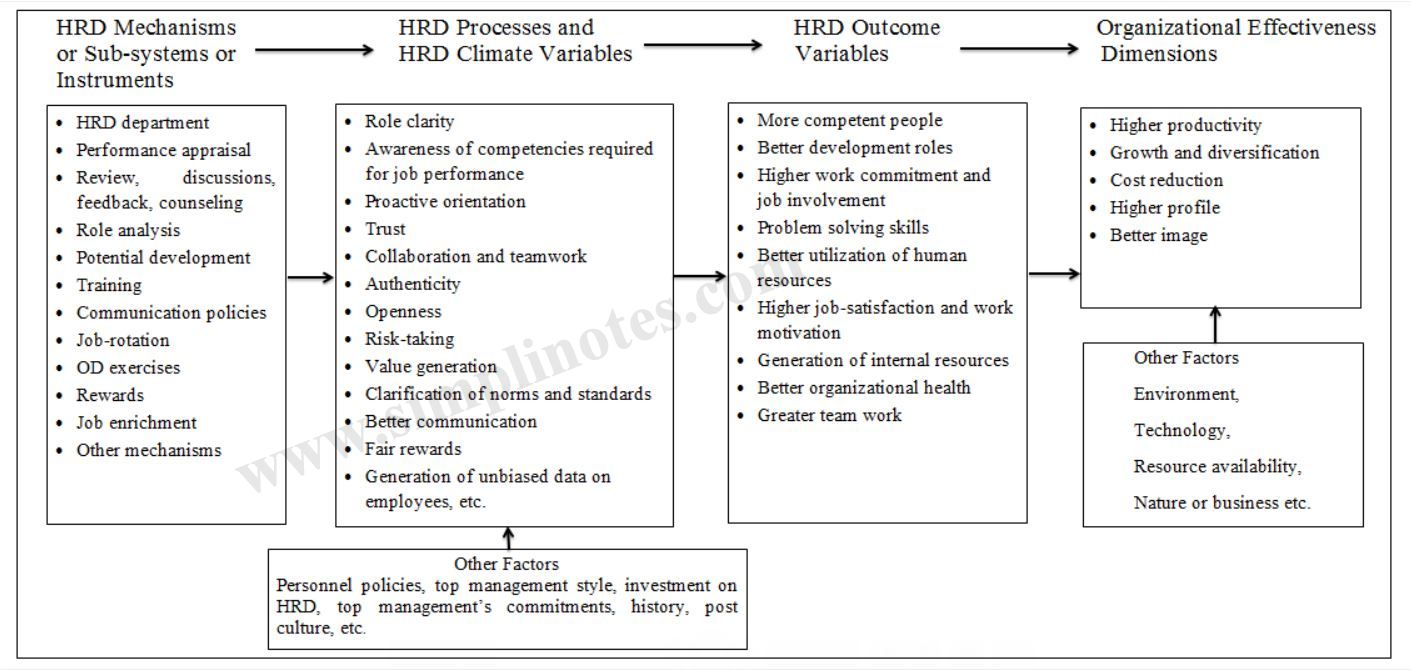HRD Matrix
The HRD Matrix shows the interrelationships between HRD instruments, processes, outcomes and organisational effectiveness as shown in the following figure:
1. HRD instruments
These include performance appraisal, counselling, role analysis, potential development, training, communication policies, job rotations, rewards, job enrichment programmes, etc. These instruments may vary depending on the size of the organisation, the internal environment, the support and commitment of the top management, the competitive policies, etc.
2. HRD processes
The HRD instruments lead to the generation of HRD of processes like role clarity, performance planning, development climate, risk-taking, dynamism in employees. Such HRD processes should result in more competent, satisfied and committed people that would make the organisation grow by contributing their best to it.
3. HRD outcomes
As shown in above figure, HRD instruments and processes make people more committed and satisfied, where they tend to give their best to the organisation enthusiastically.
4. Organisational effectiveness
Such HRD outcomes influence the organisational effectiveness in the long-run. It may be noted that organizational effectiveness also depends on a number of variables like environment, technology, competitors, etc.
1. HRD Mechanisms/Sub-systems/Instruments
Human resource is the most important resource and needs to be developed to achieve the organizational goals. It has to be developed in a way that is beneficial both to the individual and the organization. It is necessary to have a healthy and open climate to implement the process of human resource development. Trust and mutual collaboration will lead to employee commitment. If organization is able to develop the sense of belongingness then the effectiveness will be higher in the organization as it will boost the morale of the employee.
To achieve this objective following techniques are to be adopted :
i. Performance appraisal
ii. Potential appraisal and development
iii. Career planning
iv. Feedback and performance
v. Counselling
vi. Role analysis
vii. Training
viii. Job enrichment
ix. Job rotation
x. Quality circles
xi. Human resource planning
xii. Organization development
xiii. Rewards and employee welfare
xiv. Quality of work life
xv. Recruitment, selection and placement
Thus it is the responsibility of every organization to develop human resource and maintain a healthy working climate. These mechanisms are explained below:
i. Performance Appraisal
Performance Appraisal: If the performance of people is to be enhanced, performance appraisal is a systematic and objective way of judging the ability of an employee in performing his job. An HRD-oriented performance appraisal also includes determining and communicating to the employee how he is performing the job and also establishing a plan for improvement. In HRD-oriented organisations, performance appraisal is a periodic exercise, conducted on a regular basis.
For details click on the link below:
Performance Appraisal – Meaning, Definitions, Features and Evolution
ii. Potential Appraisal
If people are to be put on higher organisational positions in future, potential appraisal becomes absolutely essential. Potential’ refers to the abilities possessed by an employee but not put to use currently or the abilities to assume challenging responsibilities in future assignments. Potential appraisal is done with the purpose of developing hidden talents of employees in order to enable them to occupy higher positions in the organisational hierarchy and undertake higher responsibilities. This would not only be an effective motivator but also an excellent developer of human power. In HRD-oriented organisations, potential appraisal is a regular exercise. Career Planning: A career is a sequence of work-related positions held by a person during a lifetime.

